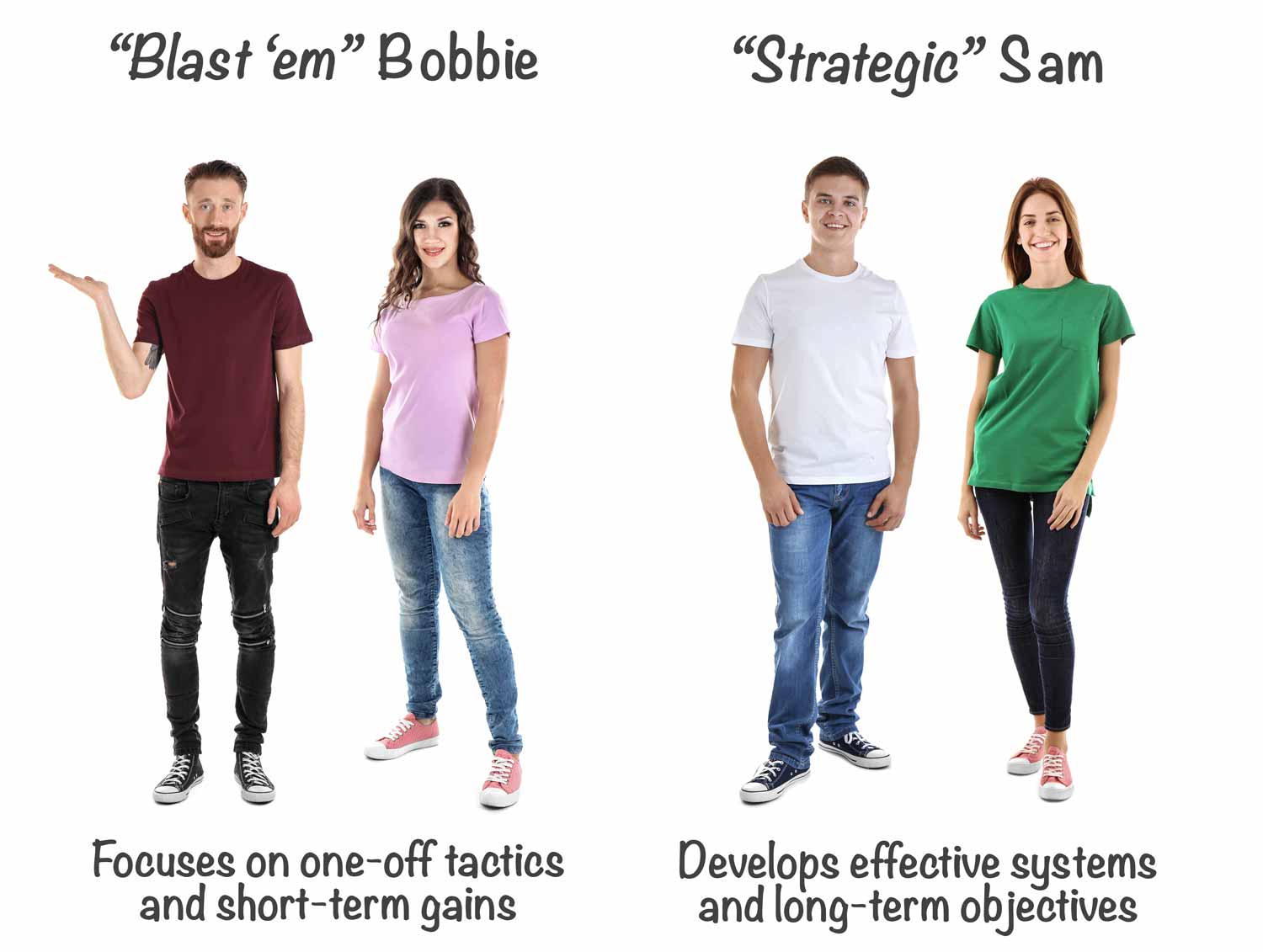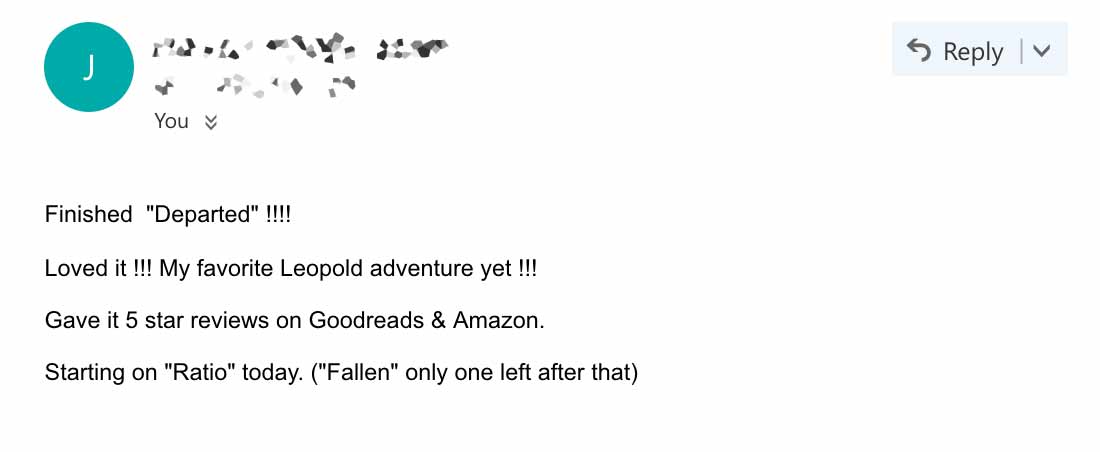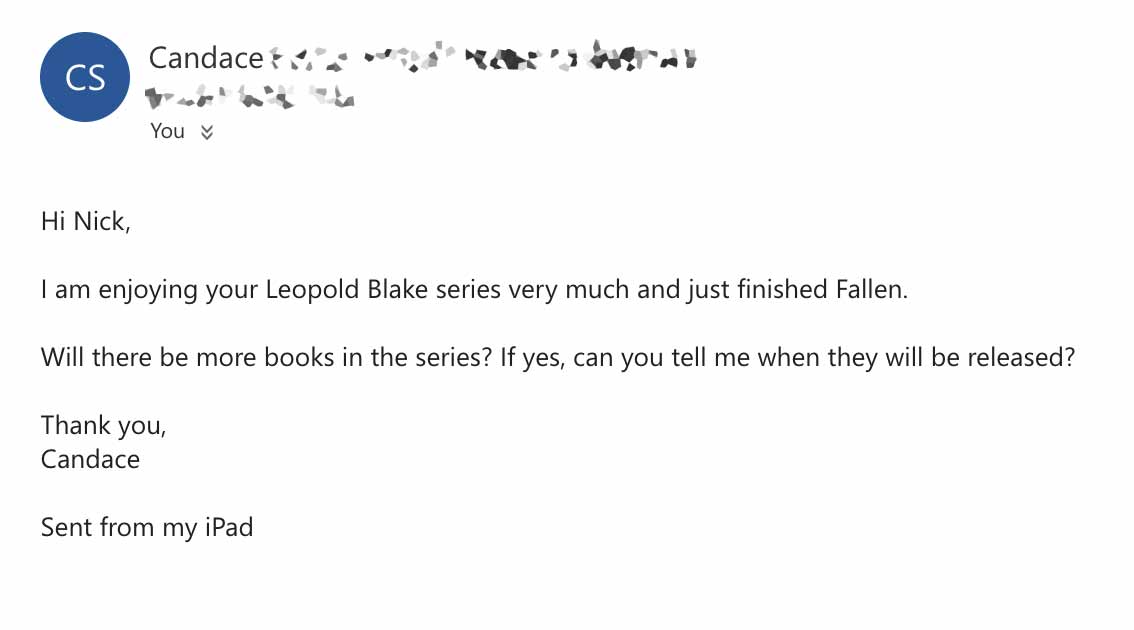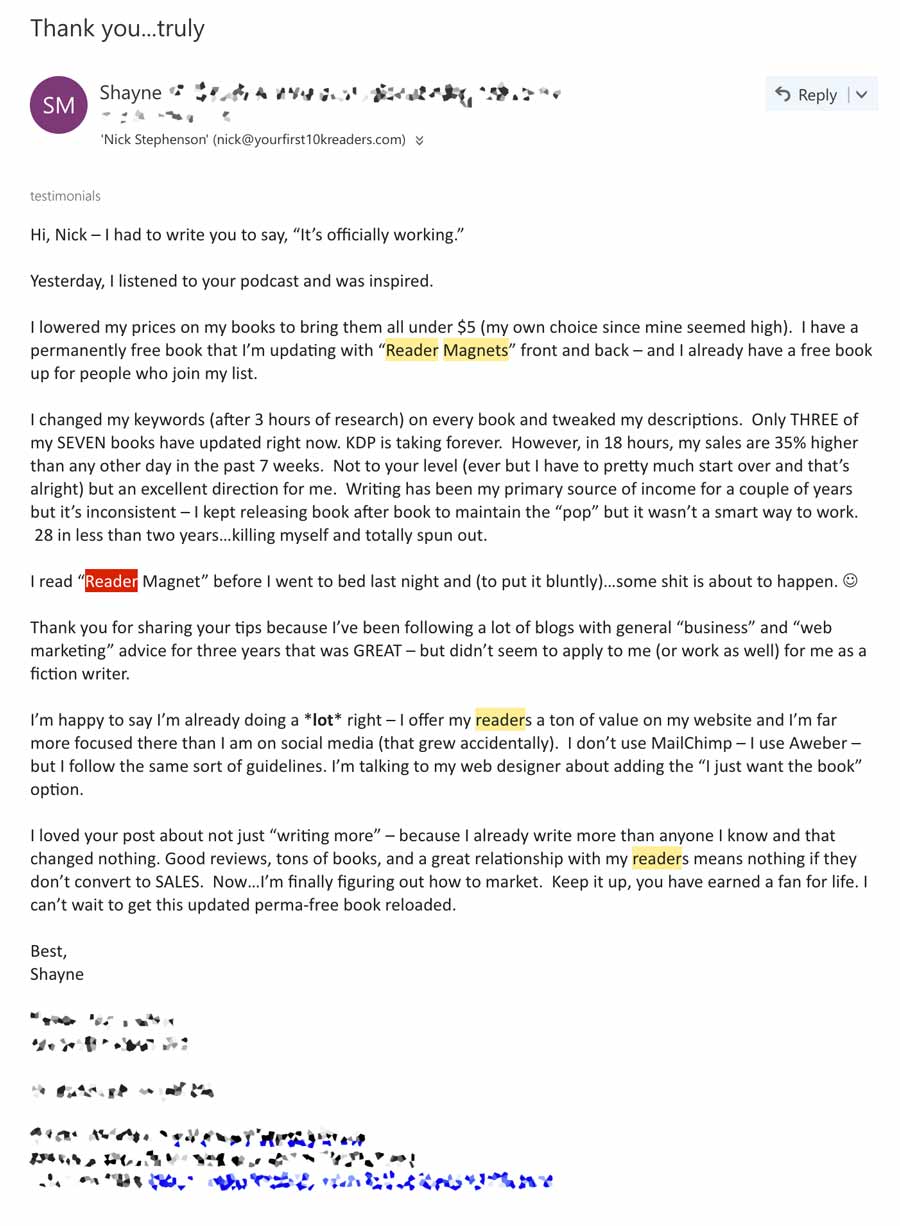
“There's a funny thing that happens when I talk to authors about email marketing. When the topic heads that way, I can literally see people's faces drop.”
They say things like:
At first, I assumed this was just nerves talking. But the more I spoke to people, the more I understood what was really going on.
You see, it doesn’t make any sense – on the surface. Here, you’ve got an author who can crank out a 100,000 word novel in a few months… but who can’t find 500 interesting words to fill up an email.
It seemed crazy to me. But actually, there’s something much deeper at play here.
When you sit down to write a book, you generally have a solid idea of what you’re going to write. Sure, you might be a “plotter” (someone who plots out every little detail) or you might be a “pantser” (someone who writes “by the seat of their pants”) or you might be somewhere inbetween.
But whichever planning and outlining style you prefer, you always have an idea in mind. Generally, you know the rough idea of the story you want to tell, some major plot points, character ideas, and the “tone” of your book.
The same for non-fiction – before you start writing, you’ll have a good understanding of the problem you’re trying to solve, or the “information gap” you’re trying to fill.
But when it comes to email?
It’s like a lightbulb actually turns OFF. And all those creative juices just… well, who knows where they go. And you end up with this:
 Cue Blinking Cursor of Death (BCOD)
Cue Blinking Cursor of Death (BCOD)
In reality, a GREAT email – namely, one that helps drive action from your readers and further your business’ purpose (we’ll get to that in a minute) – is no different IN PRINCIPLE to a great book.
The only difference is, it’s much shorter. And more focused. And you don’t have the benefit of months of planning, execution, and rounds of checking, editing, and bouncing ideas of people – or a team behind you to make sure everything is good to go. Oh, and you’re reaching out direct to readers instead of letting Amazon and the other stores do all that.
(Wait a minute, okay – NOW we’re zeroing in on why authors find email scary…)
But the thing is – you HAVE the skills already. If you can write a good book, you can produce effective emails.
And just like you follow a “system” to write a great book (idea, outline, structure, scenes, writing, editing, proof-reading, beta reading, cover, etc) you can follow a “system” for email too.
(I use the word “system” on purpose, because it’s no good knowing how to write ONE great email and then not being able to duplicate, replicate, automate, and scale up).
So, instead of just using email to “blast people” with sales messages whenever you have a launch, you can create an effective – and scalable – system that works to build desire in your audience and turn strangers into fans (meaning, more sales for you).
I spent a long time digging through 1,100+ responses to a survey I sent out, asking authors, “What’s your #1 problem with email marketing”?
From these results – more on that a little lower down the page – a “composite” character formed in my head.
This character – whom we’ll name “Blast ’em” Bobbie – is the polar opposite to “composite character #2”. Here’s how that looks:

(Note: even though Bobbie and Sam aren’t “real” flesh-and-blood people, they are 100% based on the real traits I’ve seen listening to real people).

Hi, I’m Bobbie. And I’m a “part-time author”. That is, I try to write as much as I can during my free time, which doesn’t leave a lot of space for other stuff like “marketing”.
Everybody says I should be doing email marketing, but – honestly – the thought of emailing strangers about myself and my books is terrifying. I’d much rather just focus on writing and leave the marketing parts up to other people. I’ve tried out lots of different approaches online, and nothing’s really moving the needle for me.
One of the big issues with email marketing for me is what would I write about that readers wouldn’t find boring? I really don’t think I’m all that interesting!
So far, I’ve been growing a (small) email list and, to be honest, I only really email people when I have a launch going on, so it might be a few months in-between hearing from me. The annoying thing is, my readers are only too happy to download my free stuff, but when I ask them to actually BUY something… it’s crickets.
Honestly, I think I just need MORE people on my email list, but growth is as slow as treacle. If I could only blast enough emails out to people I only need a small percentage to convert and that should help. But it’s tricky to find the time when I work a “real job” and have all this other stuff I need to do to get my books written and published.

Hey, I’m Sam – and I’ve been doing this “author thing” for the last 15 years. Well, I’ve been writing books for 15 years, but it’s only in the last 5 that things have taken off – now I’m proud to call myself a “full-time author”.
Email marketing is a HUGE deal for me. It was tricky at first to get the right balance between offering valuable content and actually ASKING people to buy my books and other products, but after a lot of practice I figured out what my audience responds to.
I kept an eye on the key metrics, took those emails performing best and developed a series of “automated sequences” that ALL my new readers go through.
Now, I’ve got “launches” and promotions going on all the time, and whenever I have a new book ready to go, I know it’s bound to end up in the top #100 on Amazon – and stay at the top of the charts for several weeks or months afterwards.
Like my friend Bobbie, I used to just blast out sales emails whenever I had a promotion going on. But I found my readers got burned out pretty quickly. Now, I have a long-term strategy and system in place that does most of my marketing for me – meaning I can get back to finishing off that next WIP.
Everybody goes through a “Blast ’em Bobbie” phase in their lives. We’re not born with an innate talent for crafting effective email campaigns.
And you might see yourself as Bobbie right now, but that’s okay (and if you do, make sure you drop me a comment at the bottom of the page, I’d love to hear from you).
The good news is, like anything else, this is a skill that can be learned. If you choose.
Where Bobbie focuses on “making sales” every time an email goes out, it’s easy to see why it’s difficult to come up with ideas about “what to write”. When the focus is on “selling” all the time, instead of thinking about “what’s in it for the readers”, it’s understandably an unpleasant process for everyone involved – especially when the results just aren’t coming.
But every “Blast ’em Bobbie” is just one mouse-click away from changing all that, and shifting focus away from short-term “tactics” and “email blasts” into something that nurtures and promotes long-term growth, happy readers, and sustainable sales.
Bobbie focuses on short-term gains, and “flash-in-the-pan” tactics. Sam understands that a successful business is something that grows over time, a process that gets worked on – continuously. Bobbie focuses on “making sales”. Sam focuses on creating real value for an audience… the list goes on.
You probably get the idea by now. This is a journey everyone can start right now. And I want to show you one possible outcome of that journey:
I’ve shown you a possible “end point” for you in that video. Some of the mechanisms and systems we have in place there are fairly complex, but we didn’t start that way (and neither should you).
The reason I wanted to share all this with you is when you have a plan, a strategy, and a system you know works – guess what? That email you’ve got to send out tomorrow isn’t scary or frustrating any more. Building up a “welcome series” or “launch series” is as simple as following a plan. If you’re doing it right, it’s actually FUN.
(And it gets you results – key point there).
So, let’s break it down. How do we get to the point where your systems look a little something like ours? Let’s break it down.
I mentioned at the top of this page that there are three major elements to creating an effective email “system”. Under each element – which together form your STRATEGY – there are several “tactics” you’ll need to employ to make it work.
Strategy through to execution. We’re going to cover both.
These are the three major elements which will form your overall email marketing strategy (make a note of them):
When you have all three working together, you’ve got an email marketing approach that will nurture your readers, turn “casual browsers” into fans, drive more clicks, reviews, and sales – and, most importantly, will allow you to scale up and automate – leaving you free to get back to writing.
Of course, it all sounds good in theory. But it’s how you EXECUTE that matters. And each “element” of the strategy above has some work that needs doing underneath it.
I’ll get to that in just a minute – first, it’s important to understand how this approach is going to help you.
You might be like Cate, who – among other things – struggles to find the time to DIY her way through “how to write effective emails”:
“Time is an issue as I work full time as a teacher, home school the resident teenager, run a household/small property, and actually try to write fiction sometimes. So WHEN do I fit email marketing in is another issue.”
Or Anna, who has a terminal fear of being “boring”:
“Sending an email to one person is easy. Sending an email to hundreds or thousands of people is scary - how do I know what these subscribers are interested in? What if I email them boring content and they decide to unsubscribe?”
Or Rebecca, who struggles to know “what to write” inbetween launches:
“I struggle figuring out what to write to keep people engaged between launches! I only launch 2 books a year at the moment, on a very loose schedule, and I tend to send lots of emails in the lead-up to launch and then nothing for months.”
Or Tad, whose audience seems to run for the hills when he tries to promote:
“I’ve had some sales but am a beginner. What’s bothering me now is that I worked hard on an email that was really supposed to sell and bring up the sales rate. It fell flat! Now I’m scratching my head.”
I’ve taken these four examples from over 1,100 responses to the question: “What’s your #1 struggle with email marketing?”
 ^^ Some of the raw data I’ve been digging through last week
^^ Some of the raw data I’ve been digging through last week
All the authors who replied fall into one of several camps – the “Blast ’em Bobbie” traits I explored with you above:
You might fit into one of those camps, or several. Or, you might have a slightly different issue altogether. But the reason I’m sharing this with you is:
When you have an email marketing strategy in place, and you’ve executed on it, you’ll have an asset that will drive sales and growth for your author business. And, instead of “worrying” about “what to write” in your next email, you’ll have it all planned out already. It can literally be as simple as filling in the boxes.
That’s where it gets fun.
Let’s go a little deeper…
We’ve mentioned the three “elements” of your email strategy already – (1) Create Awesome Content, (2) Drive the RIGHT Actions from your Readers, and (3) Automate and Scale.
Supporting each of these “pillars” are actions you’ll need to execute to drive your overall strategy – and turn it into something that actually gets you results.
Here’s how that looks:
These are the “elements” and the “supporting tactics” that we’ll use to build an email marketing system that will grow your business, your book sales, and help grow an audience of fans who LOVE you (and actually look forward to your emails).
 ^^ TR spent $497 on one of our products within minutes of the launch email going out – and actually thanked us for selling it to him… because we’d spent weeks working on “the journey”.
^^ TR spent $497 on one of our products within minutes of the launch email going out – and actually thanked us for selling it to him… because we’d spent weeks working on “the journey”.

^^ John bought one book during an email promotion, left a review, and started reading the rest
 ^^ Candace bought during a launch promo and is asking for more a few days later…
^^ Candace bought during a launch promo and is asking for more a few days later…
 ^^ Shayne buys 2 of our non-fiction books, put the teaching into action, sees results quickly, and becomes a fan for life
^^ Shayne buys 2 of our non-fiction books, put the teaching into action, sees results quickly, and becomes a fan for life
On the following pages I want to break this all down for you and give you the tools you need to build a system like this for your own business.
I’ll take you behind the scenes and show you exactly what I’ve learned over the last 5 years (including all the “bad” stuff at the beginning – I think you’ll recognise a lot of it) and lay it all out for you.
Getting this right changed everything for me. And I believe it could help you too.
I have more to share with you, if you want it. If you’re ready to try something different, I’ll lay out the entire framework for you – but only if you’re ready to get stuck in. So, my question: are you interested in learning how to do all this?
Leave a comment below and tell me – are you a “Blast ’em Bobbie” or a “Strategic Sam?” Can you see yourself making some changes? Let me know, I’ll reply personally.
NB: you might need to be logged in to Facebook to see the comments section.
© Your First 10,000 Readers
Privacy | Terms | Disclaimer